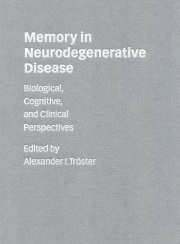Book contents
- Frontmatter
- Contents
- List of contributors
- Preface
- PART I Biological perspectives
- 1 Nonhuman primate models of memory dysfunction in neurodegenerative disease: contributions from comparative neuropsychology
- 2 Nonprimate animal models of motor and cognitive dysfunction associated with Huntington's disease
- 3 Neuropathology and memory dysfunction in neurodegenerative disease
- 4 Neurochemical aspects of memory dysfunction in neurodegenerative disease
- 5 Structural neuroimaging correlates of memory dysfunction in neurodegenerative disease
- 6 Functional neuroimaging correlates of memory dysfunction in neurodegenerative disease
- 7 The biology of neurodegenerative disease
- PART II Cognitive perspectives
- PART III Clinical perspectives
- Index
4 - Neurochemical aspects of memory dysfunction in neurodegenerative disease
from PART I - Biological perspectives
Published online by Cambridge University Press: 23 November 2009
- Frontmatter
- Contents
- List of contributors
- Preface
- PART I Biological perspectives
- 1 Nonhuman primate models of memory dysfunction in neurodegenerative disease: contributions from comparative neuropsychology
- 2 Nonprimate animal models of motor and cognitive dysfunction associated with Huntington's disease
- 3 Neuropathology and memory dysfunction in neurodegenerative disease
- 4 Neurochemical aspects of memory dysfunction in neurodegenerative disease
- 5 Structural neuroimaging correlates of memory dysfunction in neurodegenerative disease
- 6 Functional neuroimaging correlates of memory dysfunction in neurodegenerative disease
- 7 The biology of neurodegenerative disease
- PART II Cognitive perspectives
- PART III Clinical perspectives
- Index
Summary
INTRODUCTION
The relationship between ‘classical’ neuroanatomy and what has been termed the ‘chemoarchitecture’ of the brain is formidably complex, and discussions of that relationship always run the risk of oversimplification. Patterns of selective cell degeneration have been described in certain exemplary disorders (Alzheimer's, Parkinson's and Huntington's diseases), and yet such observations only inform Nieuwenhuys' important caveat that neuromediatorspecified neuronal populations do not obey simple rules (Nieuwenhuys 1985).
This chapter addresses the major neurochemical changes in three archetypal degenerative disorders – Alzheimer's disease (AD), Parkinson's disease (PD) and Huntington's disease (HD) – in the context of a review of ‘classical’ and ‘chemical’ neuroanatomies pertinent to each. Some implications for a neurochemical understanding of normal memory are discussed at the chapter's conclusion.
ANATOMICAL AND NEUROTRANSMITTER CONSIDERATIONS
Alzheimer's disease
Large cholinergic neurons populate several structures in the basal forebrain that in essence form a continuum, including the nucleus basalis of Meynert, nuclei of the diagonal band of Broca and the medial septal nucleus. Mesulam divided the forebrain cholinergic neuronal population into four major groups (Mesulam et al. 1983), of which Ch4 (roughly corresponding to the nucleus basalis of Meynert, but also including cholinergic neurons located within the internal and external medullary laminae of the globus pallidus) is of particular interest.
Cholinergic innervation of the neocortex and amygdala derives largely from Ch4 (Struble et al. 1986) and, in turn, Ch4 receives reciprocal cortical innervation from ‘limbic’ structures, including orbitofrontal, medial and polar temporal, prepiriform and entorhinal cortices (Mesulam and Mufson 1984). Loss of cholinergic neurons particularly in the nucleus basalis is characteristic in AD, though by no means the only hallmark of the disease (Whitehouse et al. 1981, 1982).
- Type
- Chapter
- Information
- Memory in Neurodegenerative DiseaseBiological, Cognitive, and Clinical Perspectives, pp. 87 - 99Publisher: Cambridge University PressPrint publication year: 1998

